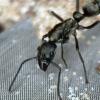Hello! I'm new to ant stuff, and I wanted to do a research project on ants, it needs to be completed before April, I was wondering what would be a good ant species to use that is relatively cheap and have a colony size of 200-300 ants total that either grow quickly, or come with a lot of workers, and a good place to buy ant farms that are relatively cheap and can house up to around 200-300 ants. I would like the ant farm to be thin, and to be able to see the vast majority of the ants all at the same time. My budget for each ant colony is $100 MAX, ideally less than $20 but I feel like that's not going to happen. Links would be appreciated but any help, is great!
If your in the US, I would recommend getting a nest from Tar Heel Ants here ($40) and getting a colony of Black Carpenter Ants (Camponotus pennsylvanicus) from Stateside ants here if your ($29) the only problems with this type of ant is that they have to hibernate during the winter (November-February) they will eventually surpass your size of 200-300 workers and the nest but that will take about 2-3 years (the max size of a colony is around 5000-10000 in my experience but that would take years). The total would be around $75 (w/ shipping) but you wouldn't have to get the nest immediately because they could reside in the test tube for a while. They love eating crickets, fruit flies, and sugar water. In my opinion they are a very rewarding and fun species to keep. If you don't like the idea of buying an ant colony, then you can go and catch a queen. In my opinion this is the best way to keep a colony because you get to have the colony all throughout their life. The only issue is it's not really their mating season right now. If you can't buy the colony because of the range here is a link to some Western Carpenter ants (Camponotus modoc). These guys are basically the same just native to different areas. If you want them to grow a bit faster you can heat them with a heating cable or heat pad. Just make sure not to put this next to the hydration gradient.
carpenter ants is an easy but slow growing, I would recommend tetramorium immigrans or lasius niger, they are easy and have explosive growth speed and are very hardy, good for small experiments, but you can always use another species. Formica is recommended for you if you want a big species, they grow insanely fast for their size but in my experience, all three that I mentioned hibernate
Also, if you want to observe ants digging, you have to use a specialized mixture for tunnel digging usually called “dig fix” it does not collapse and kill your ants when they dig too much or use a mixture of sand and clay, aka loam if you can’t buy any
and there are not many digging nest so you can try to diy one, use a box as an out world and a bead container as a nest (just an example) there are also more cheap alternatives like Por amor ant shop, you can buy the nest and ship them to the US but not the ants and they have a nest that allows them to dig and it has instructions
Edited by OwlThatLikesAnts, September 9 2024 - 1:07 PM.
Currently keeping:
1x Formica subsericea, 35-40 workers + maybe eggs *New* 2x Camponotus nova, one has only larva
1x Crematogaster cerasi, All workers is ded  *extreme internal screaming* 1x Myrmica ruba sp around 10 workers + pupa
*extreme internal screaming* 1x Myrmica ruba sp around 10 workers + pupa
*New* 1x Temnothorax curvispinosus, 101 or something worker + 3 or 4 royal mom ants + pile of white ant worms
*As you watch your ants march, remember that every thing begins with a small step and continued by diligence and shared dreams* -A.T (which is Me)
Sadly due to unforeseen consequences, I will soon be giving away my colonies (I will miss them though  )
)

















